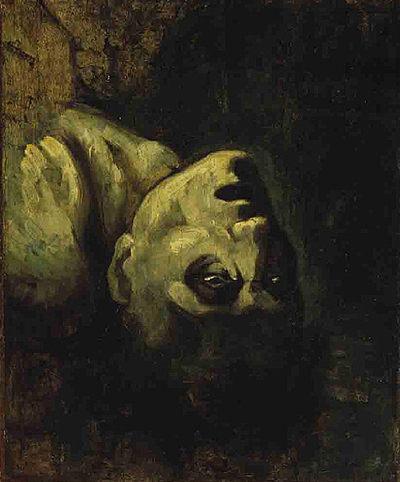Painted in 1819, probably shortly prior to the creation of his best-known work, The Raft of Medusa, Gericault's Head of a Drowned Man marks a clear break from neoclassical tradition with its stark realism. Theodore Gericault notoriously painted straight from life, sketching and painting a human figure as he saw it.
In 1819, Gericault attracted controversy with his decision to visit local morgues, and bring severed arms and heads back to his Paris studio to enable anatomically accurate representations. Drowned men were peculiarly topical to his efforts to convey the tragedy of the Medusa ship raft, poorly constructed and marooned off the African coast for 13 days before being discovered with very few of the 140 victims still living. Gericault's depictions of scenarios that spared nothing, invoking the very present rawness of emotions, would continue to influence such painters as Paul Delaroche (1797 - 1856). Unlike Delaroche, Gericault treated very much with the present, as opposed to compositions of historical scenes, such as the execution of Lady Jane Grey.
There was nothing romantic about the tragedy of the Medusa raft, even as there was nothing romantic about the sketch of a drowned man's head. In his Head of a Drowned Man, Gericault breaks from his traditional use of a warm pallet of paints. Instead, he favours a greenish tinge to the whole, which cleverly convey a sense of underwater weed streaming from hair and clinging to skin, and the murky depths of ocean that engulf the victim. The drowned man's eyes are notably lifeless, with sightless pupils rolling towards the inside his head, which is tilted backwards, eternally to rest on the floor of the ocean. Gericault has similarly captured his subject's mouth agape.
Combined with the dark and forbidding layers of paint that have been used to create the backdrop, the overall sense one gains from viewing the work is of choking, claustrophobic, overwhelming panic. It isn't possible to see what is behind the head. Is it detached from the body? And what is the brownish mass beyond the head? What other horrors do the waters hold? Cleverly, intricately, Theodore Gericault has rendered onto canvas the real effect and movement of water; the slight green margin around his subject's chin texturises how water pools around a solid object. Gericault's gaping victim's mouth is so realistic in the way it hangs, forever seeking and denied oxygen, that is almost has the viewer gasping for air in sympathy.




